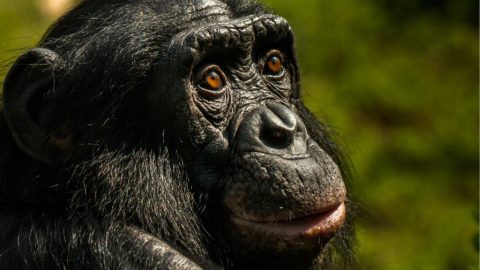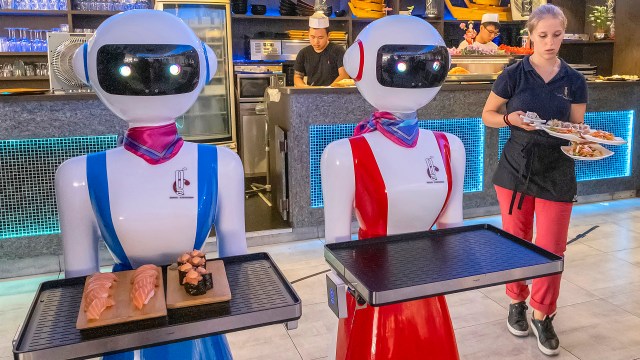How we differ from chimps

We humans occupy an interesting place in the world. We’re animals, with the same organs and biological drives as dogs and chimpanzees. But a nighttime satellite view of Earth suggests that there’s something a bit different about us: gossamer ribbons of light and clusters of cities sparkle in the darkness, blazing out a signal to the rest of the cosmos that this particular animal has stumbled on civilization. Are we unique after all?
Frans de Waal, one of the world’s foremost experts on chimpanzees, thinks not. Years of observing chimpanzees have convinced him that the gap between humans and their great ape cousins is thin and permeable—more a matter of degree than kind. In a recent interview for Nautilus magazine, de Waal argued that chimpanzees boast culture and moral emotions such as sympathy. For example, different bands of chimps in the wild have different customs and patterns of tool use. These culturally distinctive behaviors aren’t genetically programmed instincts. Instead, chimps must learn them from each other, just as humans learn their own cultures’ techniques and norms. Chimps also console injured friends and grieve for the dead.
But biology is defined by nonlinear systems, in which small changes along one dimension produce radical jumps in another. Add grains of sand one at a time to a sandpile, and at some point the sandpile will suddenly collapse—even though all you did was add one more measly grain. The differences between humans and chimpanzees are like this. Chimps have intelligence, sociality, dexterity, and communication skills. But somewhere along the line, incremental increases in these abilities ignited a combinatorial explosion, producing an entirely new kind of animal.
Three examples illustrate this nonlinear shift:
Excellent mimics
First, our imitation and mimicry skills are significantly more complex than those of our simian brethren. Sure, captive chimpanzees can learn to mimic hand gestures and other actions, and they learn tool use by watching each other. On the scale of social animals, chimpanzees are good—even excellent—imitators.
But human beings are another thing entirely. We not only learn by watching each other, but we actively demonstrate skills to each other, slowing down and doing things step-by-step in order to make clear how exactly one carves a canoe, threads a needle, or hooks a fish.
Even more oddly, we faithfully copy even actions that seem to have no point at all. Both chimpanzees and human children quickly learn how to open a box to receive a treat by observing an experimenter do it first. But only human subjects will copy purposeless sequences of hand gestures before releasing the latch—for example, tapping the box three times and waiting five seconds before opening it. Chimpanzees quickly intuit that these extraneous actions aren’t necessary for getting the treat, and so they sensibly ignore them.
Why do we copy pointless motions? As anthropologist Joseph Henrich points out, many complex technological skills must be learned in stages over long periods of time, requiring a high level of trust during the learning process. You may not know why you’re supposed to hold your fingers this particular way when drawing the bow, but you do know that the best hunters all do it this way. So you copy them without knowing why. Thus, while chimpanzees may seem wise to spurn the most impractical actions, it’s actually our human willingness to copy everything—even the most meaningless hand gestures—that enables us to develop and pass down game-changing technologies.
Language is a big deal
The second example is language. Even de Waal concedes that if there’s a single trait that differentiates people from other animals, this is it. Of course, basic building blocks for language are already present in chimps: highly articulate lips and facial muscles, vocal control, sociability. But again, incremental, seemingly minor enhancements to each of these skills suddenly make it possible for humans to do things that no other animal can: tell each other about the past, the future, and imagined things.
This is a very big deal.
Other animals can plan for and imagine the future and remember the past. But only people can craft sentences that precisely describe future or counterfactual scenarios, and so export their dreams from one mind into the next. That’s because animal signals—such as grimaces, postures, and vocalizations—are tethered to the here and now. When a chimpanzee howls in pain, she’s actually in pain. But I can write a few words and evoke in your mind the idea of pain without either of us having to suffer an iota of discomfort.
Language, in turn, allows people to generate what might be called social institutions and separable roles by enabling us to confer symbolic value on things. In a chimpanzee band, the alpha male is the individual who can intimidate all the other animals into paying obeisance to him. But in a human tribe, the chief and the shaman are roles, distinguishable from the people who happen to occupy them at any given time. A person can be a doctor because we call her doctor: a normative social role, only possible with language.
In this way, language equips people to augment the objective world with a socially constructed layer of norms, rules, roles, and statuses. A person isn’t just a member of a band—she’s a member of a particular tribe, with its own symbols, rituals, and obligations. And while chimpanzees feel sympathy and may have an incipient sense of fairness, they don’t have a sense of obligation.
As the evolutionary anthropologist Michael Tomasello points out, obligations apply only to specific statuses within symbolic groups. I’m obliged to pay rent because I live in a building owned by my landlord. “Ownership,” “rent,” and “tenancy” are all abstract concepts, recognized by members of my society but not all others. Because they’re abstract, they’re unthinkable—or at least not communicable—without language.
Invisible beings
The final example of a nonlinear shift brings the first two together: religion. While chimps sometimes gather together for “rain dances” that have some ritual-like features, they don’t have ceremonies dedicated to invisible beings. Nor do they have initiation rites, wedding ceremonies, ceremonial fasting, or taboos.
By contrast, human societies everywhere have rituals and ceremonies that point to concepts that are either not immediately present or not perceptible: gods, spirits, ancestors. And unlike all other animals, human beings often refuse certain foods or abstain from food or sex not because they’re injured, but because of religious or cultural obligations.
Language makes religion possible because it enables people to both imagine and communicate about abstract ideas, such as “creator god” or “ritual purity.” Simultaneously, our capacity for copying apparently purposeless behaviors with high fidelity is custom-made for learning and transmitting cultural rituals, which, after all, are complex sequences of actions with no utilitarian objective.
Together, language and high-fidelity copying make up the necessary ingredients for religion. Religion, in turn, represents the ultimate nonlinear shift in the evolutionary story of humankind.
Only a few incremental changes in some key traits—articulated vocalization, high-quality motor mimicry—separate us from our great ape forebears. But those small changes along one axis triggered a quantum leap in cognition, social organization, and imagination.
The post How We Differ from Chimps appeared first on ORBITER.





